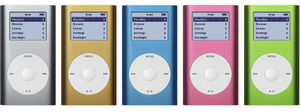Difference between revisions of "IPod mini (1st generation)"
m (1 revision imported) |
|
(No difference)
| |
Revision as of 04:01, 22 August 2022
 Pictures of the 5 colors for the 1st gen iPod mini | |
| Developer | Apple |
|---|---|
| Generation | 1st |
| Release date | January 6, 2004 |
| Introductory price | $249 |
| Discontinued | February 23, 2005 |
| Units sold | ---- |
| CPU | 2x PortalPlayer PP5021C ARM processors @ 80 MHz |
| Memory | 225 bytes (32 MiB) |
| Storage | 4GB (Microdrive) |
| Display | 1.67" monochrome LCD at 138 x 110 pixels |
| Successor | iPod mini (2nd generation) |
| ARBL | 8 hours MP3/AAC playback |
| Battery | 450 mAh Li-Po |
| External Interface | 30-pin Dock (FireWire AND USB, sync & charge) |
| Maximum capacity | 237 bytes (128 GiB)[2], with up to approx. 20,000 songs Song limit is caused by RAM limitations, and can be bypassed using Rockbox. |
The iPod mini (1st generation) is the first model in the iPod mini series. Released by Apple on January 6, 2004, the iPod mini (1st generation) was successful throughout the entirety of its sale period as a smaller and cheaper alternative to the iPod.
The iPod mini came in five different colors: silver, gold, blue, green and pink. Unlike the iPod (3rd generation) that was Apple's main iPod offering at the time, the iPod mini had a rounded aluminum design, with plastic top and bottom covers. This design would later be reused on some models of the iPod nano.
Advertising
Advertising for this model mostly consisted of banners in the street, magazines and in apple.com, one of which was "Small, Mini", depicting the 3rd generation iPod above the Mini which was showcased in the iTunes page. There has been more advertising models for it and will be added as soon as they've been found.
Modifications
Due to their commonality, praise given from popular iPod YouTuber DankPods, and their usually low price used, the iPod Mini is a very popular choice for people's first iPod flash mod, alongside the iPod video and iPod classic (7th generation). Doing this modification has more advantages than just more storage. Examples are increased battery life and more durability. This is due to the removal of moving parts. The iPod Mini has a spinning hard drive by default. These harddrives can be damaged by movement and require more power to spin.
They are very comfortably modifiable, have an easy-to-open shell, and a CompactFlash drive connection that allows for CF cards and CF to SD card adapters, such as the iFlash one. The only common difficulty some may face is the removal of the bezels, which are usually glued down; using a hair dryer to heat up the glue may help with this.
The iPod Mini has the ability to be flashed to run custom firmware. Examples of this are iPodLinux and Rockbox. There are many advantages to doing this: games, custom software, support for extra music codecs and the possibility to bypass iTunes by placing music on the drive of the iPod.
Resources
iFixIt's Guide on the iPod mini: https://www.ifixit.com/Device/iPod_Mini
EveryMac's page for the iPod Mini 1g: https://everymac.com/systems/apple/ipod/specs/ipod_mini.html
Dankpod's guide on the iPod mini: https://www.youtube.com/watch?v=qTEk-bgB7rs
Notes
[1] Only applicable to new iPod mini batteries, when using the included Microdrive. A flash-modded iPod mini will most likely have better battery life; an older battery, worse battery life. An iPod mini (2nd generation) battery will give the first-generation iPod mini better battery life.
[2] It is unknown whether the iPod mini can handle 256 GiB or more, in a stable manner (with or without Rockbox. Theoretically, the limit would be at 2 TiB, because of Master Boot Record limitations.